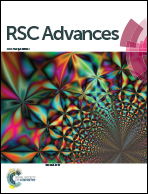DFT study on the quenching mechanism of singlet oxygen by lycopene†
Abstract
Lycopene is a kind of natural food ingredient that is one of the strongest antioxidants in nature at present. However, the mechanism of scavenging singlet oxygen is still unclear which has restricted the extensive application of lycopene in many fields. Density functional theory has been applied to optimize the configurations of the ground and excited states of lycopene and oxygen respectively. The quenching mechanism of singlet oxygen by lycopene is analyzed based on the calculations at the B3LYP/6-311+(d,p) level. The excited state oxygen in the singlet turns into the ground state in the triplet and gives out energy, while at the same time lycopene in the ground state absorbs the energy, changing into excited lycopene. The quenching process involves exchange of two electrons of different spin coming from lycopene and singlet oxygen. The quenching is spontaneous according to the calculated energy and Gibbs free energy change. Regarding energy level and the construction of frontier orbitals, electron exchange occurs simultaneously with energy transfer and change of spin. In addition, it also can be concluded that oxygen and lycopene can pass electric charge to each other in the meantime, however, it is dominated by one or the other in different stages. Overall, the close energy levels and good symmetry matching of the reactants’ frontier orbitals, lack of electron spin-flip in the quenching system, and the negative Gibbs free energy difference, all make the quenching process very easy.


 Please wait while we load your content...
Please wait while we load your content...